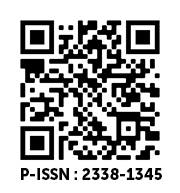The effect of varying levels of potassium hydroxide-treated false Yam seed meal on growth performance, haematology and serum biochemistry of male broiler chickens
DOI:
https://doi.org/10.36782/apjsafe.v11i2.254Keywords:
false yam seed, chemical treatment, broiler chicken, growth, bloodAbstract
This study was carried out to evaluate sequential treatment of false yam seeds as substitute for maize in broiler chicken diets on their growth, carcass, haematology and serum biochemistry. Ripped fruits of false yam plants growing in the wild were harvested by hand picking. The fruits were partially sun-dried to reduce their moisture content and facilitate cracking to obtain the false yam seeds (FYS). The fresh FYS were crushed with a stone to reduce size, increase surface area and facilitate processing. The freshly crushed false yam seeds were subjected to multiple-stage processing where seeds were first soaked in ordinary water (i.e., addition of fresh seeds in ordinary water at a ratio of 1:2, wt/vol) for 12 days with water being changed every 3 days. After the 12 days of soaking, the seed sample was washed with clean ordinary water. In the second stage of processing, soaked FYS was soaked in a solution of 1M concentration of potassium hydroxide at a ratio of 1:2 (wt/vol) for 24 hours, after which the sample was washed thoroughly with clean ordinary water. The last stage of processing involved blanching of potassium hydroxide-treated seeds, firstly by immersing the sample in hot water (900C) for 20 minutes and then transferring it into cold water (40C) for 40 minutes. The treated seed sample was then washed with clean water, sun-dried to approximately 12% moisture on a cement floor and ground into gritty flour using a hammer mill. The treated false yam seed meal was labeled as KOH_T FYSM. At 21 d of age, 128 birds were individually weighed and then randomly assigned to one of four dietary treatments in quadruplicate lots. Each replicate had 8 male broilers. The mean live-weight of birds in each replicate was 883 g (±0.05). The four treatments included the control without KOH_T FYSM; treatments 2, 3 and 4 contained 100, 300 and 500g/kg KOH_T FYSM respectively replacing maize (wt. /wt. basis) in a completely randomized design. The birds were fed various diets for 35 d. The growth response of male broiler chickens fed diets supplemented with varying levels of KOH_T FYSM revealed no significant (P<0.05) difference in all growth parameters measured. Carcass dress weight and carcass dressing showed no significant (P>0.05) difference at 500g/kg. However, the relative weight of organs revealed a significant (P<0.041) increase in the heart weight and a reduction in the weights of the liver and the spleen. Haematological parameters evaluated revealed a significant (P<0.05) decrease in the haemoglobin, mean corpuscular volume, mean corpuscular haemoglobin and mean corpuscular haemoglobin concentration as KOH_T FYSM was increased in the diets. The economics of replacing maize with KOH_T FYSM in the diets of male broilers revealed that price per kg of feed reduces as the test material was increased in the diets. Inclusion of KOH_T FYSM up to 500g/kg in the diets of male broilers had no adverse effect on their growth performance. However, its inclusion influenced internal organ weights such as the liver, spleen and heart. Economics of feeding KOH_T to broilers did not increase cost of feeding, suggesting that, There is an economic value for using this product for broiler chickens as an alternative to maize during periods of scarcity and can be recommended for use by farmers where this plant is available.
Downloads
References
D’Mallo, J. P. F. and Walker, A. G. (1991) Detoxification of jack bean (Canavalia ensiformis): studies with young chicks. Animal Feed Science Technology, 33:117-127.
Dei, H.K, Adjokatse, R.A, Abdulai, S, Amoako, G.K, Mohammed, A. and Teye, G.A. (2011). Evaluation of Nutritive Value of (Icacina oliviformis) Seed Meal in Broiler Chicken Diets. British Poultry Abstracts, 7: 26-27.
Dei, H.K., Adzokatse, R.A., Abdulai, S., Amoako, G.K., Mohammed, A. and Rose S.P. (2014). Effects of varying processing techniques on nutritive value of false yam seed meal in broiler chicken diets. Ghanaian Journal of Animal Science, 8(1): 79-86
Dei, H.K., Gborkey, W., Yaro, D. and Mohammed, A. (2013). Nutritional value of soaked false yam tuber and seed meals in chicken diets. Ghanaian Journal of Animal Science, 7 (1): 33-39.
Dei, H.K., Wallah, T.A. and Mohammed, A. (2012). Effect of soaking duration on nutritional value of false yam (Icacina oliviformis) seed meal for broiler chickens. Proceedings of Crop Livestock Integration Workshop. GILLBT, Tamale. 27-28th August, 2012. P. 124-129.
Donkoh, A., Atuahene, C.C. and Ofori, S.K. (1998). Effects of Solar dried blood meal on growth performance of broiler chickens. Proceedings of the 24th Ghana Animal Science Symposium Vol.2: 108. 26th – 29th August 1998, KNUST, Kumasi, Ghana.
Fay, M. J. (1991). Icacina oliviformis (Icacinaceae): A Close Look at an Underexploited Food Plant ІІ. Analysis of Food Products, Economic Botany 45(1) 16- 26.
Harvey, R. B., Kubena, L. F., Huff, W. E., Elissalde, M. H. and Phillips, T. D. (1991). Hematologic and immunologic toxicity of deoxynivalenol (DON)-contaminated diets to growing chickens. Bulletin of Environmental Contaminants and Toxicology. 46:410–416.
Kamphoff, M., Thiele, T. and Kunz, B. (2007). Influence of different extraction parameters on a solid-phase dynamic extraction for the gas chromatographic determination of d-limonene degradation products by using a fractional factorial design. JAOAC international, 90 (6): 1623-7.
Kasei, C.N. (1988). The physical environment of semi-arid Ghana. In: Unger, P.W. Sneed, T.V. Jordan, W.R. & Jesen, R. (Eds) Challenges in Dryland Agriculture: a global perspective, Texas, Texas Agric. Expt. Station, 350-354.
Lange, B.M., Wildung, M.R., Stauber, E.R., Sanchez, C., Pouchnik, D. and Croteau, R. (2000). Probing essential oil biosynthesis and secretion by functional evaluation of expressed sequence tags from mint glandular trichomes. Proceedings of National Academy of Science. USA, 97, 2934–2939.
Larbier, M. and Leclercq, B. (1994). Nutrition and Feeding of Poultry (J. Wiseman, trans. and ed.) Nottingham University Press, Loughborough. UK. 305pp.
McDonald, P. Edwards, R.A. and Greenhalgh, J.F.D. (1995). Animal Nutrition. 4th Edition. Longman Group Ltd., Essex, England, 405 – 491.
Mohammed, A. and Dei, H.K. (2013). Effects of soaked false yam (Icacina oliviformis) tuber meal on feed digestibility, performance and haematological characteristics of layer chickens. Ghanaian Journal of Animal Science, 7 (2): 105-116.
Mohammed, A., Dei, H.K., Addah, W., Roessler, R. and Schlecht, E. (2019). Proximate components, minerals, amino acids and some anti-nutrients in processed false yam seed meals: Potential benefits for poultry nutrition. Scientific African (6) e00180.
Nagalakshmi, D., Sastry, V.R.B., Agrawal, D.K., Katiyar, R.C. and Verma, S.V.S. (1996). Performance of broiler chicks fed on alkali-treated neem (Azadirachta indica) kernel cake as a protein supplement. British Poultry Science 37: 809-818.
Nagalakshmi, D., Sastry, V.R.B., Katiyar, R.C., Agrawal, D.K. and Verma, S.V.S. (1999). Performance of broiler chicks fed on diets containing urea ammoniated neem (Azadirachta indica) kernel cake. British Poultry Science 40: 77-83.
Nelson, F.S. (1993). Growth Performance and Economics of Broiler Production Using Diets Containing Oil and Palm Oil Slurry. Proc. 6th Animal Science Conference Pp 69. Ghana Society of Animal Production. UCC, Cape Coast, Ghana.
Oluyemi, J. A. and Robert, F.A. (1979). Poultry Production in Warm Climate. Macmillan, Basingstoke. Pp 134-135
Pommer, L. (2003). Oxidation of terpenes in indoor environment: A study of influencing factors. VMC, Umea, Sweden. P. 1-96.
Roessler, R., Amprako, L., Sayibu, A.R., Mohammed, A., Menezes, R.C., Hölscher, D., Alenyorege, B., Dei, H.K. and Steiner, C. (2017). Effects of false yam tuber meals and charcoal on broiler chicken production and blood parameters. South African Society for Animal Science. 47: 842-853.
Smith, A.J. (1990). Poultry. The tropical agriculturalist, Macmillan, London and Basingstoke. 218 pp.
Tachie-Menson, C.K.B. (1991). Steps in Rearing Chicken. Asempa Publishers, Accra, Ghana. pp 1-87.
Vanhaelen, M., Planchon, C., Vanhaelen-Fastre, R. and On’Okoko, P. (1986). Tepenic constituents from Icacina senegalensis. Journal of Natural Products, 50 (Suppl.2): 312.
Vidal-Valverde, C., Frias, J., Estreella, I., Gorospe, J.M., Ruiz, R., Bacon, J. (1994). Effect of processing on some anti-nutritional factors of lentils. Journal of Agriculture and Food Chemistry 42: 2291-2295.









